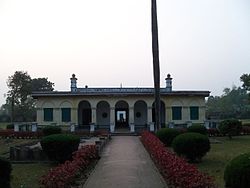Khushbagh (also spelled as Khoshbagh; literally "Garden of Happiness") is the garden-cemetery of the Nawabs of Bengal, situated on the west bank of the Hooghly river, about a mile from its east bank, in the Murshidabad-Jiaganj CD block in Lalbag subdivision of Murshidabad district, West Bengal, India.[1][2][3][4] Khushbagh hosts the graves of the Nawabs of Bengal of the Afshar dynasty and their family members; while Jafarganj Cemetery hosts the graves of the later Nawabs and their families, starting from Mir Jafar, who belonged to the Najafi dynasty. Khushbagh is the resting place of Nawab Siraj ud-Daulah, his wife Lutf-un-nisa, Nawab Alivardi Khan, and his mother, amongst others.
| Khoshbagh | |
|---|---|
 Entrance of Khushbagh | |
 | |
| Details | |
| Location | Murshidabad, West Bengal, India |
| Country | India |
| Coordinates | 24°09′45″N 88°15′32″E / 24.162610°N 88.258911°E |
| Style | Islamic architecture |
| Size | 7.65 acres |
| No. of graves | Graves of Nawab Siraj ud-Daulah, Lutfunnisa Begum, Nawab Alivardi Khan, Alivardi Khan's mother and other members of the family of the Nawabs of Bengal |
| Website | "Khoshbagh". |
Geography
edit5miles
Nala
River
River
border checkpost
M: municipal town, CT: census town, R: rural/ urban centre, H: historical place
Owing to space constraints in the small map, the actual locations in a larger map may vary slightly
Location
editKhushbagh is located at 24°09′45″N 88°15′32″E / 24.162610°N 88.258911°E.
Note: The map alongside presents some of the notable locations in the subdivisions. All places marked in the map are linked in the larger full screen map.
History
editThe garden-cemetery was built by the first Nawab of Bengal, Nawab Alivardi Khan. It consists of walled enclosures. The outer walls had looped holes for musketry and used to be flanked by octagonal bastions.[1] The garden hosts the graves of Siraj ud-Daulah and Alivardi Khan, inside a square, flat-roofed mausoleum surrounded by an arcade verandah.[1] It also hosts a mosque, built by Nawab Alivardi Khan, on the lines of the Jama Masjid of Delhi, built on a plinth of 2,675 square feet (248.5 m2) area.[1]
After the death of Nawab Siraj ud-Daulah, in the Battle of Plassey in 1757, his wife Lutfunnisa Begum refused to join Mir Jafar's harem and fled to Dacca (present day Dhaka, in Bangladesh). She later returned to Murshidabad, and it is said that she lived in Khushbagh tending to his grave and the 108 varieties of roses which once bloomed in the gardens, for several years. She also allegedly spent ₹1,000 for the maintenance of Khushbagh and after her death, in 1790, she was buried near the grave of her husband Nawab Siraj ud-Daulah.[1]
The garden-cemetery is built on a 7.65 acres (3.10 ha) land and is surrounded by a 2,741 feet (835 m) long wall.[1]
Gallery
edit-
Tomb of Nawab Alivardi Khan
-
Tomb of Nawab Siraj ud-Daulah
-
Tomb of Lutfunnisa Begum
-
Tomb of Amina Begum, mother of Siraj ud-Daulah
-
Tomb of Ghaseti Begum, the eldest daughter of Alivardi Khan
References
edit- ^ a b c d e f "Information on Khushbagh". Murshidabad.net. Retrieved 26 November 2012.
- ^ Pratapaditya Pal; National Centre for the Performing Arts; Enamul Haque (1 November 2003). Bengal, sites and sights. Marg Publications. p. 151.
- ^ Bengal (Volume 86). The Society. 1967.
- ^ Kalikinkar Datta (1963) [First published 1939]. Alivardi and his times (2nd ed.). Calcutta: World Press. p. 136.
His [Alivardi's] dead body was buried at the foot of his mother's grave at Khushbāg on the west bank of the Bhāgrathi opposite Motijhil.
External links
edit- "Khushbagh — Murshidabad.net".
- Murshidabad travel guide from Wikivoyage